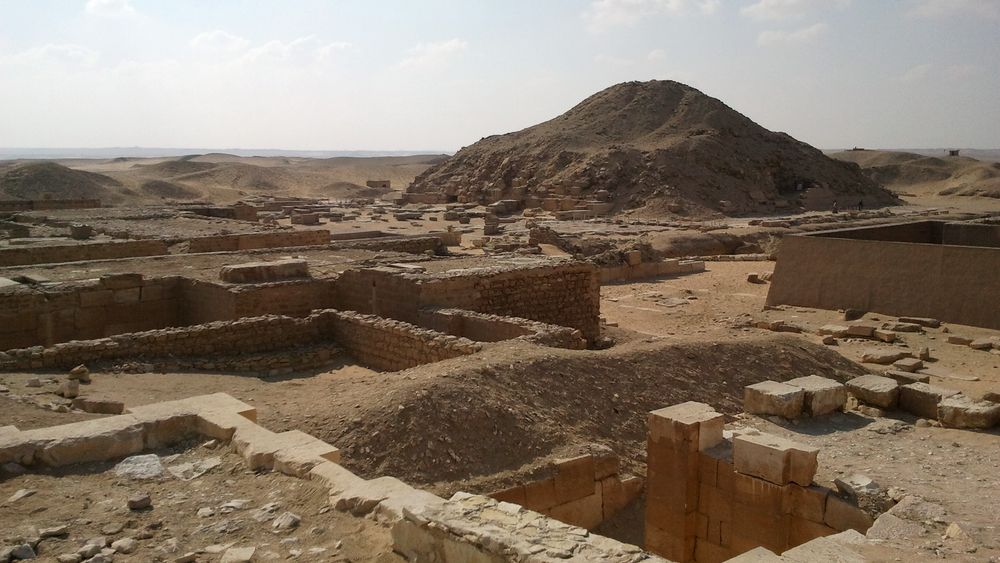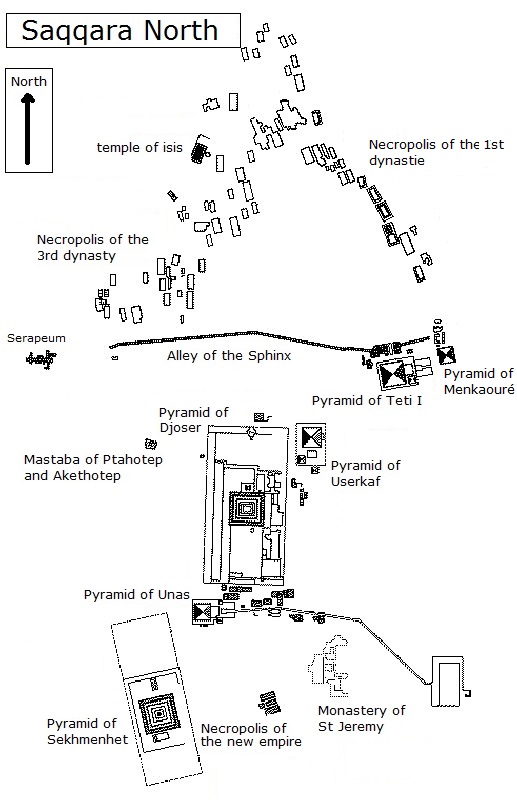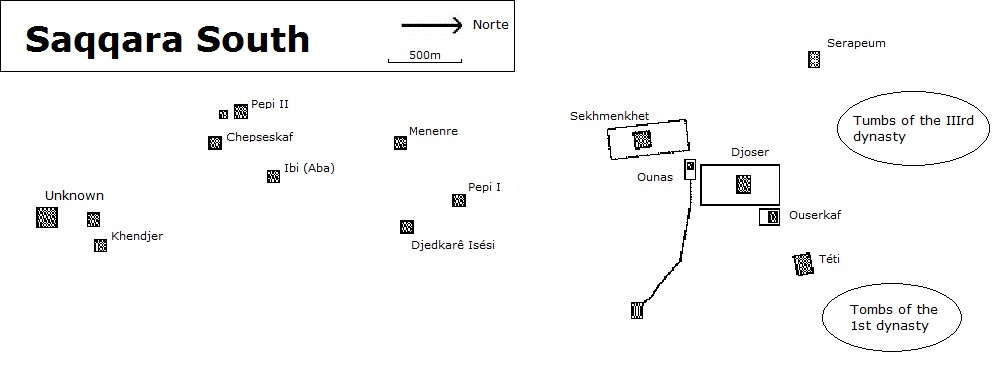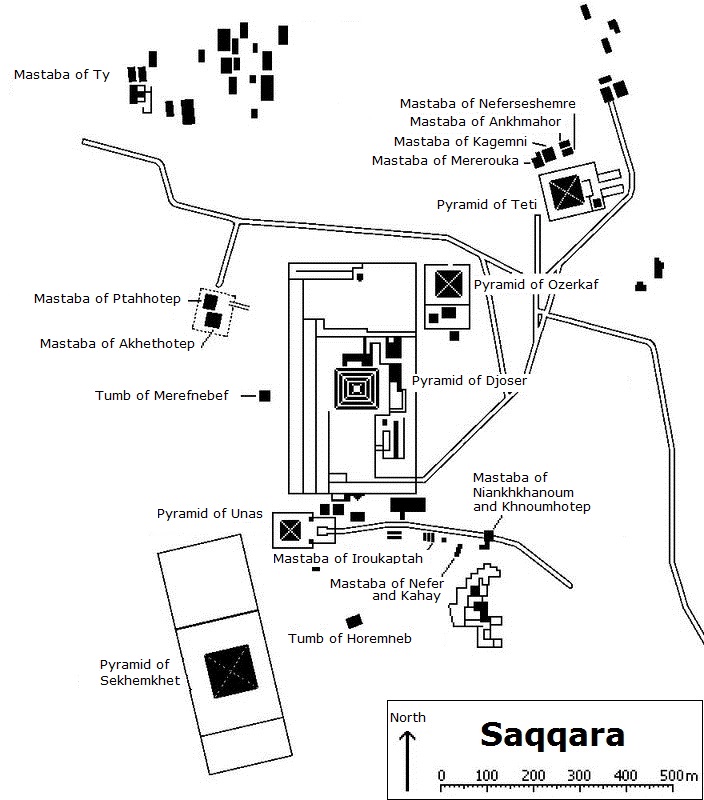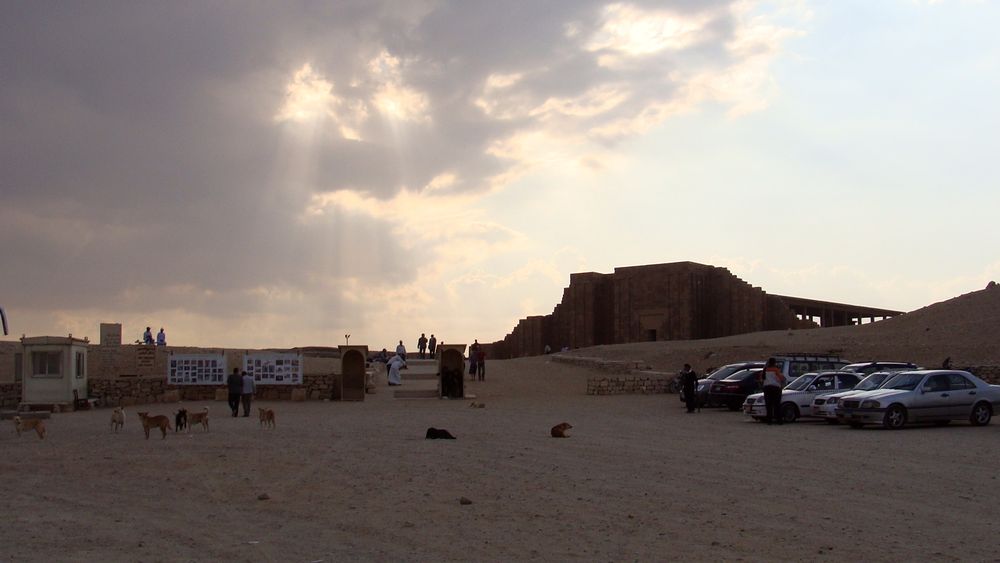The necropolis of Saqqara is the largest group of Egyptian tombs of antiquity. The site was exploited as a necropolis from the 1st Dynasty, and it will be during the whole of the old empire, with periods of abandonment, before being updated again during the New Kingdom.
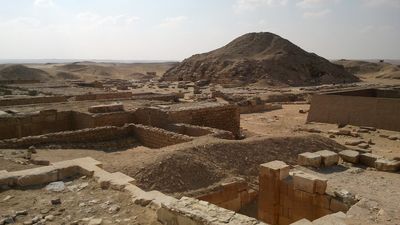
Plateau of Saqqara
It is an exceptional archaeological site, filled with royal tombs or not, and whose centerpiece is undoubtedly the funeral ensemble of Djoser, first pharaoh of the 3rd dynasty.
Location
The necropolis of Saqqara is an Egyptian historical site located on the west bank of the Nile, like most of the necropolises of ancient Egypt.
This is an interesting state of affairs in that it shows a part of the spirituality of ancient Egypt. Indeed, at that time, the inhabitants thought that their soul, the famous "Kâ", was part of a whole, that it unfolded in all things and that it returned in a kind of big river from where was drew the Kâ of the newcomers. In this vision, all that is alive forms a cycle, the mind being constantly renewed, passing from an occult to a luminous face. This cycle was represented by the race of the Sun which was born every morning in the East and lay down every evening in the West. Hence the representation of the East as the kingdom of the living, and the West as the realm of the dead. The Nile, natural border, marked this separation.
More exactly, Saqqara is about 15 km south of the Giza Necropolis, facing the city of Memphis. It is bordered by the necropolis of Dahshur in the South and Abousir in the North.
Arrangement of the graves
In detail the arrangement of the tombs is relatively simple, at the necropolis of Saqqara. The necropolis is oriented North-South about 8Kms long, with a central part more developed than the rest of the area. Saqqara is adjacent to the necropolis of Abousir which is just to the north, and further afield is that of Giza. In the South, there is that of Dahshur.
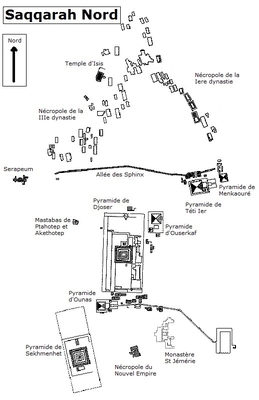
Map of Saqqara North (Click to enlarge)
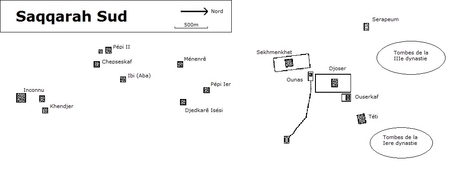
Map of Saqqara South (Click to enlarge)
To the north are large groups of archaic tombs, dating back to the 1st Dynasty (in the East) and the 3rd Dynasty (to the West). It is there that is also the temple of Isis. South of these tombs, a long, Sphinx-lined alley separates these archaic tombs from the much more advanced funerary complexes of the 5th Dynasty. On the south side of this path are the Menkaouré complex, the Sekmenket complex, the Userkaf complex and, of course, the very first pyramid that has never been built by mankind. that of Djoser , an integral part of his funeral complex. It should be noted that this pyramid is from the 3rd dynasty, so it was the first of this area. This central area was also used to accommodate the graves of many high dignitaries during the 5th Dynasty, there are high quality mastabas.
A little further south is the necropolis of the New Kingdom, built centuries later, then. During the eighteenth dynasty General Horemheb is buried here. Then, we built the Serapeum, a temple dedicated to the God-Bull Apis. From the nineteenth Saqqara dynasty is again put forward and wins new buildings, before being abandoned again. Saqqara will still be used during the 30th Dynasty, that is, towards the end of the New Kingdom, under the reign of the Ptolemies.
In this area of the new empire is also a curiosity, the monastery St Jeremiah. Today largely ruined, it is a monastery created in 470 and enlarged during the 6th century. It was attacked by the Arabs during the seventh century, rebuilt and finally abandoned in 960. The ruins are interesting to visit nowadays.
Going further south is a vast arid area known as Saqqara-South, which contains various funerary complexes, mainly from the 4th, 5th and 6th dynasties. However, there is the tomb of Pharaoh Khendjer, the XIIIth Dynasty.
History
The first tombs date from the 1st Dynasty, they are built in a very archaic style denoting the weak knowledge of the population of the time as an architect. These tombs are rather north of the site.
A little further south are the first pyramids, culminating in the Pyramid of Djoser. They were built as early as the Third Dynasty but it was under the 5th and 6th Dynasty that this site bristled with pyramids, some royal.
Then, at the end of the old empire, Saqqara was abandoned, the capital passing from Memphis to Thebes, then to Licht. The middle empire abandoned Saqqara, which underwent a revival under the new empire, under the eighteenth and nineteenth dynasties, with the construction of numerous tombs of high-ranking people in the administration of the time, very hierarchical.
Area
The necropolis of Saqqara is impressive: It measures 6Kms long and 1.5 wide, the largest area for an Egyptian necropolis (16Km2, surroundings). It is a vast flat limestone plateau approximately flat which dominates the valley of the Nile.
Historical interests
Explored for 150 years, the necropolis of Saqqara allowed the discovery of many tombs and pyramids, most of which date from the old empire. The remains of these tombs make it possible to understand how the inhabitants of the time lived, thanks to representations or objects of high quality, objects that were analyzed in a precise way.
Excavation
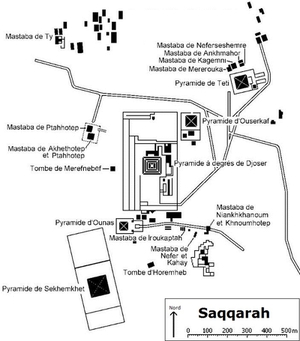
Plan of the main graves (Click to enlarge)
The Saqqara plateau has been explored several times, but still after the Napoleonic expedition. Indeed, when Napoleon Bonaparte landed in Alexandria in 1798, Saqqara was not really studied, it is still a vague area of which we hardly notice that the Step Pyramid of Djoser that emerges from the rubble.
The first exploration of the pyramid of Djoser dates from this time, it is due to General Enrico Menu von Minutoli (1772-1846), head of the scientific mission, which was sent to Egypt in 1818 by the Prussian government. He joined the skills of the Italian Egyptologist Girolamo Segato (1792-1836). Twenty years later, in 1836, Colonel Richard W. Howard-Vyse (1784-1853) extracted the rubble that encumbered the site. John Shae Perring was able to draw the first precise plan of the monument, with these annexes. In 1842, Karl Richard Lepsius (1810-1884) led a new Prussian mission there. The main work he did was titanic: he had to make an inventory of the monuments of ancient Egypt. This work includes of course the remains of Djoser. His work will be published in the "Denkmäler aus Ägypten und Äthiopien" ("Monuments of Egypt and Ethiopia") in 1849-1850, with many plates.
But the first explorer to understand the Saqqara site as a whole was the Frenchman Auguste Edouard Mariette (1821-1881). He devoted his entire career there and will be rewarded by the discovery, on November 12, 1851, of the Serapeum.
Nowadays the site of Saqqara is in perpetual excavations, we discover very regularly new tombs that come to feed the great book of the Egyptian knowledge.
Various temples
The site of Saqqara contains, besides the tombs of pharaohs and the cemeteries that accompany them, some temples and places of worship, the main ones are:
- Anubeion
- Bubasteion
- Serapeum
- Iseum
These temples were sacred places where the gods to whom they were consecrated were venerated. Anubeion was dedicated to the jackal god Anubis, the equivalent of St. Peter in the Catholic religion. It is near the pyramid of Tetis, to the east. Today, this temple is completely destroyed. The Serapeum was dedicated to the sacred bull Apis, he was to the north of the pyramid of Djoser.
The Bubasteion of Saqqara is the area dedicated to the goddess Bastet.
Known tombs
Saqqara is the place of burial of the first pharaohs, those of the first three dynasties. At the time they were buried in mastabas that became, over time, more and more complex. This is the Pharaoh Djoser who was the first to be built a pyramid, the famous step pyramid of Djoser. The tombs of Saqqara are generally classified in one of three styles: Archaic tombs, mastabas and Djoser's pyramid, but the list below is rather chronological, so there is a (voluntary) mix between styles and construction period.
You should know that the archaic tombs are simple excavations in which the deceased was buried in a fetal position and wrapped in a reed mat. Mastabas are rather rectangular-looking buildings with sloped walls and the dimensions may vary. They generally consist of two parts: The chapel, where the funerary cult was celebrated, and the vault, which could only be accessed by a well. The deceased was of course buried in the vault. The word mastaba is of Arab origin, it originally designated a hillock used to mark the place where was buried a body. Finally the third style was the Djoser degree pyramid, which is widely described here.
The mastabas of the Old Kingdom, whose reliefs, of a great delicacy, evoke most often episodes of the daily life of their owners. That of Princess Idout (daughter of Ounas), in which a female hippopotamus gives birth to her child that is about to devour a crocodile, definitely deserves a detour. From the New Kingdom, the tomb of the Mayan lady, nurse of Tutankhamun, or that of Generalissimo Horemheb (before the latter became pharaoh) are beautiful references in Memphite art for this time.
Archaic tombs (Dynasties I to III)
- Horus Aha
- Horus Djer
- Horus Djet
- Horus Den (Oudimou)
- Horus Adjib
- Horus Sémerkhet
- Horus Qâ
- Step pyramid of Djoser
- Step pyramid of Sékhemkhet (unfinished)
Tombs from the time of the pyramids (Dynasties IV to VI)
- Tomb and temple ofChepseskaf (The Matabat Faraoun)
- Pyramid and temple of Ouserkaf
- Pyramid and temple of Menkaouhor
- Pyramid and temple of the queen Néferhétepès
- Pyramid and temple of Ounas
- Pyramid and temple of Djedkarê Isési
- Pyramid and temple of Téti
- Pyramid and temple of the queen Ipout Ist
- Pyramid and temple of the mother-queen Sechséchet Ist
- PPyramid and temple of queen Khouit II
- Pyramid and temple of Pépi Ist
- Pyramid and temple of the queen Noubounet
- Pyramid and temple of the queen Inenek Inti
- Pyramid and temple of the queen Ânkhésenpépi II
- Pyramid and temple of the queen Mérétitès
- Pyramid and temple of the queen Ânkhésenpépi III
- Pyramid and temple of the queen Behenou
- Pyramid and temple of Mérenrê Ist
- Pyramid and temple of Pépi II
- Pyramid and temple of the queen Neith
- Pyramid and temple of the queen Ipout II
- Pyramid and temple of the queen Oudjebten
Late Tombs (Dynasty XIII)
- Pyramid and temple of Qakarê-Ibi
Visits
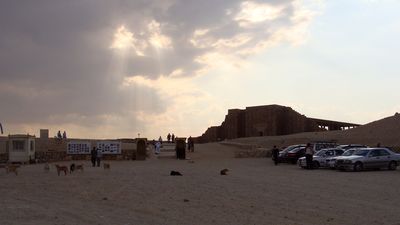
Saqqara tour parking
It is quite possible to visit Saqqara, but the complex is so big that you have to take a guide that will take you to some specific places, usually the Djoser pyramid is the main point, when it's not the only one.
Generally speaking, it is always advisable to have a local guide when visiting an Egyptian necropolis, as the places of interest are sometimes very distant, and it is better to know the places to visit. avoid walking long for not much. A guide will take you where you need it, directly.
The Saqqara Plateau is dominated by the funerary complex of Djoser and its pyramid to degree. It has a fairly traditional tour circuit: Read the tour of the step pyramid.
The Imhotep museum
There is a museum in Saqqara, the Imhotep Museum. It was inaugurated in 2006. There are sarcophagi and mummies found on this site (in a room), and everyday objects that have been extracted from the different rooms (in another room). This museum is a creation of the French Egyptologist Jean-Philippe Lauer who spent his life exploring the Saqqara site.
Learn more about the Imhotep museum.
The view
From the surrounding wall of the pyramid of Djoser whose thickness forms a terrace, an exceptional panorama embraces the whole region of southern Saqqara, starting with the small pyramid of Ounas (king of the 5th dynasty), interesting because of his texts which constitute the first literary and religious composition written on the walls of a pyramid, from where the name of Texts of the Pyramids given to these long litanies.
On the horizon, the gaze is stopped by the two pyramids of Dahshur, located about ten kilometers from our observation point. One is known as the "rhomboid pyramid", the other as "red pyramid". These two royal tombs are the work of Pharaoh Snefrou (IVth Dynasty). His son Khufu, will succeed, around 2700 BC, to build in Giza the more perfect pyramids. 147 m high, it was considered in antiquity as one of the most seven worders of the world.






